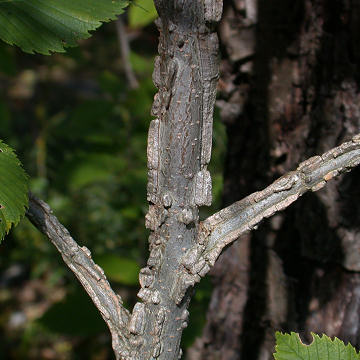

Ulmus thomasii - (image 1 of 5)
Taxonomy
Family: Ulmaceae
Habitat
Rich calcareous woods, hillside seeps, dry rocky ridges and bluffs.
Associates
Distribution
Southwest Quebec west to MN, south to NJ, WV, western VA, TN, and northern AR.
Morphology
Deciduous tree to 25 m with a strong central trunk. Bark dark gray, deeply and irregularly furrowed. Lower branches persistent and divaricate. Branchlets corky-ridged; twigs thinly hairy; mature buds pointed, longer than wide, thinly hairy. Leaves alternate, 8-14 cm long, broadly ovate to obovate, smooth to scabrous above, pinnately veined, acuminate-attenuate at the tip and symmetrical as the base, mostly minutely but distinctly auriculate-clasping, the lobes often slightly overlapping, doubly serrate. Flowers perfect, in racemes 2-4 cm; calyx merely lobed. Fruit a flat, 1-seeded, suborbicular, abruptly beaked, 1.5-2 cm samara, pubescent on the flat surface, ciliate margined.
Notes
Flowers in spring before the leaves
Wetland indicator: Facultative +
The name Rock Elm refers to the wood which is very hard. The only other elm in our area with corky-ridged stems is U. alata Michx. (Winged Elm), which has smaller leaves mostly 4-7 cm that are scarcely cordate at the base, and fruit in racemes less than 1 cm long. Winged Elm is more southern, occurring from southeast VA to southern IN, southern IL, and MO, south to FL and TX.
References
Gleason, Henry A. and A. Cronquist. 1991. Manual of Vascular Plants of Northeastern United States and Adjacent Canada. Second Ed.
The New York Botanical Garden. Bronx, NY
Swink, F. and G. Wilhelm. 1994. Plants of the Chicago Region.
Indiana Academy of Science. The Morton Arboretum. Lisle, Illinois.
|
Michael Hough © 2009 |